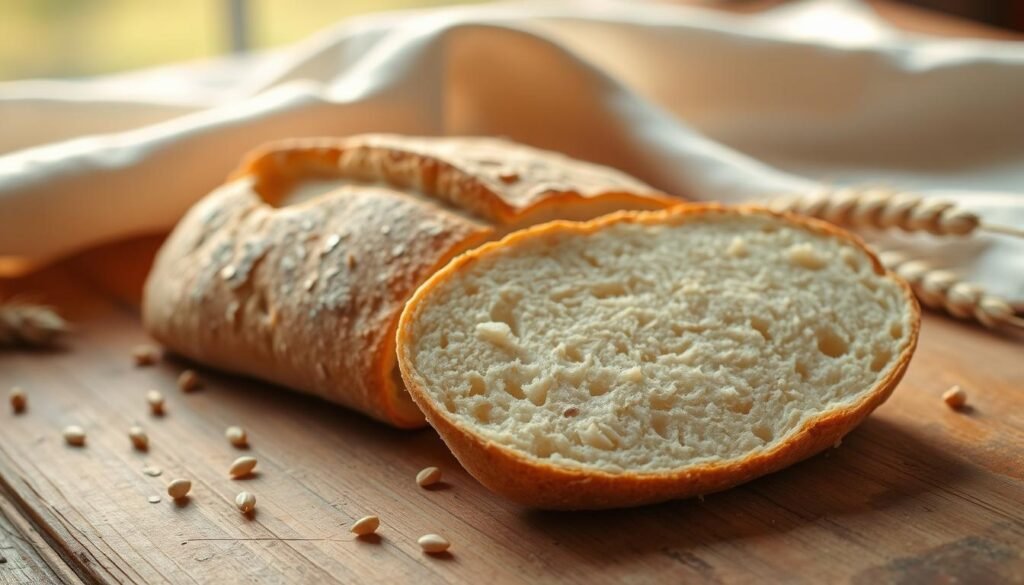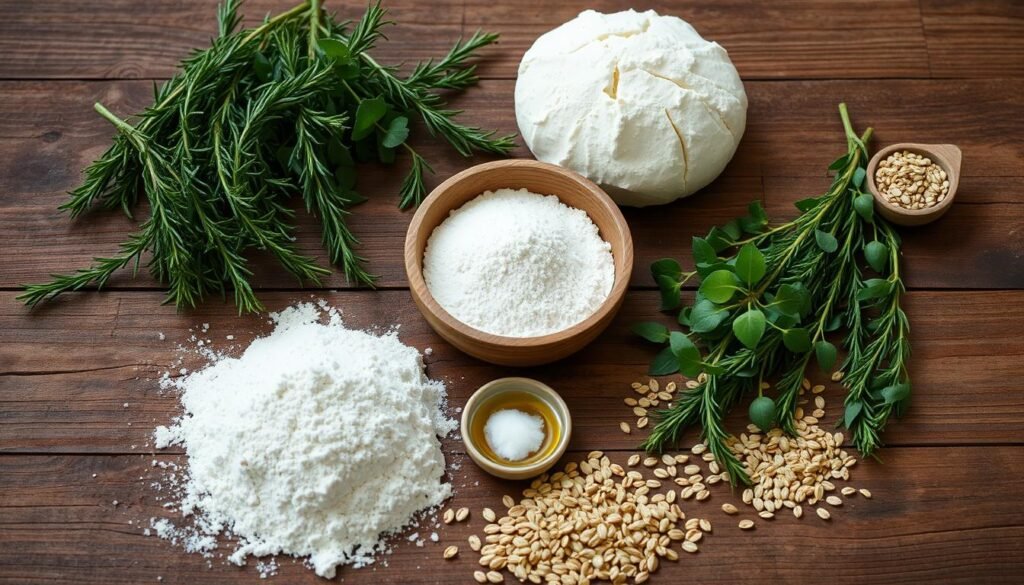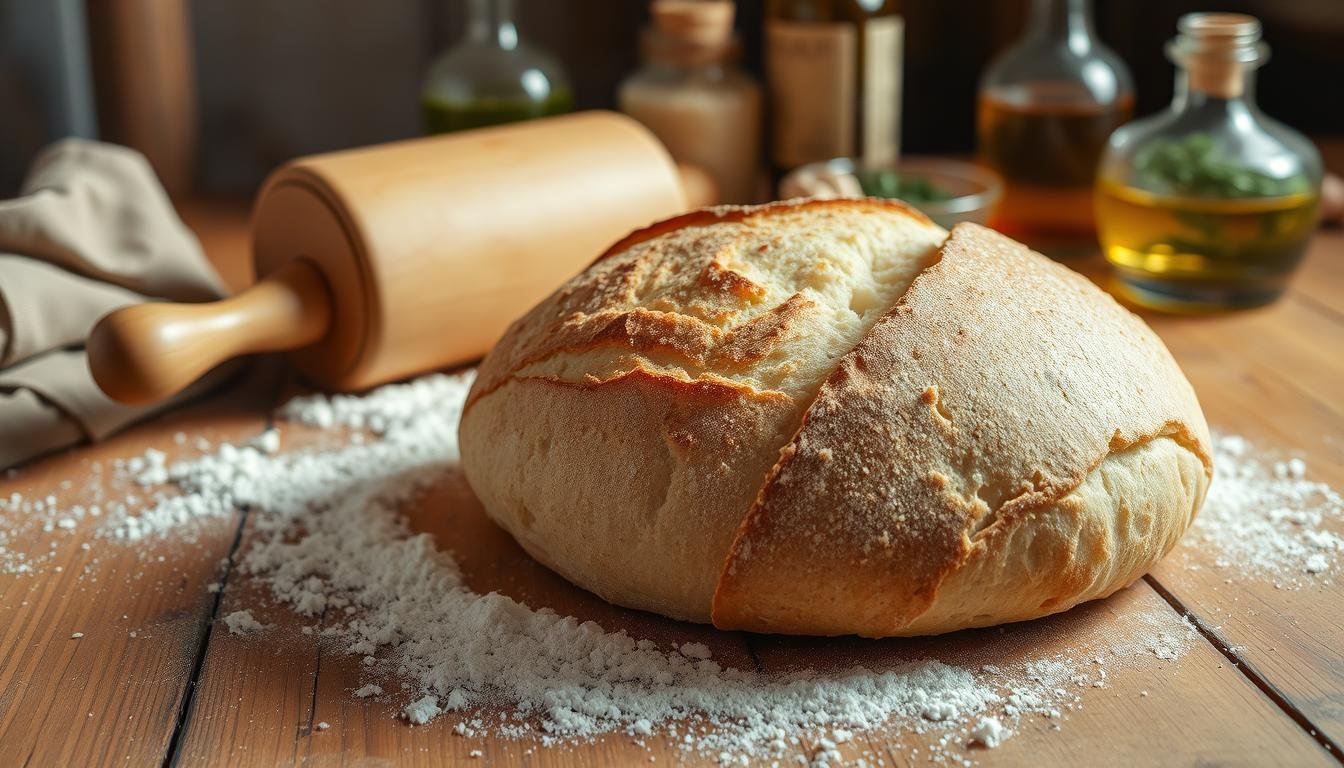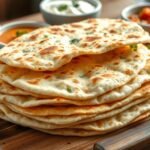Imagine a bread that’s so tasty and easy to make. It can change your meals, snacks, and gatherings. Welcome to the world of homemade unleavened bread – a yeast-free flatbread that’s soft and chewy and versatile. It’s perfect for a quick side dish or a hit appetizer.
But what is unleavened bread, and why is it so loved? Let’s explore this ancient treat and learn how to make your own soft unleavened bread at home.
Key Takeaways
- Unleavened bread is a simple, yeast-free flatbread made with just a few common ingredients
- It has a deliciously chewy texture and is incredibly versatile, making it perfect for quick meals, snacks, and dipping
- The homemade unleavened bread recipe is easy to make at home and can be customized with various toppings and fillings
- Unleavened bread is traditionally eaten during the spring Holy Days of Passover and Days of Unleavened Bread
- This bread can be stored in an airtight container at room temperature, in the fridge, or in the freezer for convenient meal prep
What is Unleavened Bread?
Unleavened bread is made without yeast, baking powder, or baking soda. It’s a simple bread with a rich history, especially in religious traditions.
A Brief History and Definition
In the Jewish tradition, it’s called matzah. It’s key to the Passover, remembering the Israelites’ quick escape from Egypt. The bread’s lack of leavening shows humility, simplicity, and truth.
For Christians, it stands for the body of Christ in communion. It’s also a common food in Central America and South Asia, like tortilla and roti.
The Significance of Unleavened Bread
The religious significance of unleavened bread goes beyond its past. The Latin Church’s Canon Law requires it for communion. Even in North America, the Hopi people make Piki bread from maize.
Yet, it’s linked to zinc deficiency, causing health issues. Despite this, its easy ingredients and quick making make it popular worldwide.

“Unleavened bread represents qualities like humility, simplicity, and sincerity.”
Unleavened Bread Ingredients
Making basic unleavened bread is simple. You need all-purpose flour, water, and a pinch of salt. Some recipes might add a bit of oil or sugar for extra flavor or sweetness.
The secret to unleavened bread’s dense, chewy texture is in mixing the dough. You want to mix the ingredients into a smooth ball without overworking. This gentle mixing keeps the dough’s simple unleavened bread recipe feel.
| Ingredient | Quantity |
|---|---|
| All-purpose flour | 2 cups + 2 tablespoons (345 grams) |
| Cold water | 1 cup |
| Salt | 1/2 teaspoon |
This simple unleavened bread ingredients list makes about 7 flatbreads. It’s great for everyday meals or special events. You can prepare it in just 5 minutes, and it bakes in 20 minutes.

“In many cultures, unleavened bread is used as a daily bread, and it is still utilized in churches for the Lord’s Supper or Communion.”
Some bakers like to use ancient grains like spelt, einkorn, or kamut for biblically-based breads. These grains have a different gluten structure than modern wheat. This gives them a unique texture and taste.
Step-by-Step Recipe Instructions
Making delicious unleavened bread is easy and rewarding. Follow these simple steps to make your own flatbread at home:
Mixing the Dough
Begin by mixing all-purpose flour and kosher salt in a big bowl. Add water slowly while stirring until the dough comes together. Then, knead the dough for a few minutes to make it smooth and stretchy.
Rolling and Cooking the Bread
Split the dough into 10 parts and shape each into a thin, round flatbread. Heat a skillet or griddle over medium-high heat. Cook the bread for about 2 minutes on each side, until it’s lightly browned. To keep it soft, stack the breads and wrap them in a towel to hold in the steam.
With these easy steps, you can make how to make unleavened bread quickly. The unleavened bread recipe instructions are straightforward. This makes a great base for many dishes.
Versatile Unleavened Bread Variations
Unleavened bread is very versatile and can be made in many tasty ways. You can make it savory or sweet, depending on what you like. This makes it easy to create unique unleavened bread dishes.
Cheesy Unleavened Bread
For a cheesy twist, sprinkle shredded mozzarella cheese on the bread after baking. Then, bake it again until the cheese melts and bubbles. This turns the bread into a cheesy, indulgent treat.
Cinnamon Unleavened Bread Sticks
Make cinnamon-sugar unleavened bread sticks for a special treat. After baking, brush the bread with melted butter and sprinkle cinnamon-sugar on top. The warm bread will stick the cinnamon-sugar, mixing savory and sweet.
These variations add new flavors and textures to traditional unleavened bread. Whether you like the cheesy bread or the cinnamon-sugar sticks, they’re sure to be favorites.
| Unleavened Bread Variation | Ingredients | Preparation |
|---|---|---|
| Cheesy Unleavened Bread |
|
|
| Cinnamon Unleavened Bread Sticks |
|
|
“Unleavened bread is a versatile canvas that allows you to explore a wide range of flavors and textures. From savory to sweet, the possibilities are endless.”
Serving Suggestions for Unleavened Bread
Unleavened bread is a versatile staple that can be enjoyed in many ways. It’s great for those observing religious traditions or looking for a gluten-free option. There are many creative ways to use unleavened bread in your meals.
One classic way is to use it with dips and spreads. Try it with hummus, baba ghanoush, or garlic-herb cheese. The bread’s sturdy yet tender texture is perfect for scooping up these tasty accompaniments.
Unleavened bread is also great for sandwiches. Fill it with grilled vegetables, roasted meats, or creamy nut butters. It makes for a satisfying and gluten-free lunch or snack.
For a heartier meal, pair unleavened bread with soups, stews, and curries. The bread soaks up the flavorful juices, adding a delightful contrast in textures.
Lastly, unleavened bread can be enjoyed on its own as a simple side dish. Top it with olive oil, herbs, or lemon juice for a delicious treat.
The possibilities are endless when serving unleavened bread. Whether you’re how to serve unleavened bread or what to eat with unleavened bread, let the bread’s natural flavors and textures shine.
Health Benefits of Unleavened Bread
Unleavened bread is a simple yet versatile food with many health benefits. It has fewer calories and carbs than traditional breads. This makes it great for those watching their diet.
The nutritional value of unleavened bread depends on the flour used. It often has a lot of fiber, minerals, and other good nutrients. It’s also a good choice for people with dietary restrictions, like those avoiding dairy or eggs.
| Nutrition Comparison | White Bread | Unleavened Bread |
|---|---|---|
| Calories per Ounce | 75 | 112 |
| Protein (per Ounce) | 4g | 3g |
| Fiber (per Ounce) | 2g | 3.4g |
| Sodium (per Ounce) | 145mg | 23mg |
Unleavened bread is a nutrient-dense alternative to traditional breads. For example, whole-wheat matzo crackers have nearly 14% of the daily fiber intake for women and 10% for men. This makes them a great source of fiber.
It’s also good for those with dietary restrictions or sensitivities. Unleavened bread can be made without common allergens like dairy or eggs. This makes it a versatile and inclusive option for many diets.
While unleavened bread may not have as many vitamins and minerals as other grains, it’s low in sodium. It also has fiber and protein. This makes it a nutritious and balanced choice for a healthier bread option. Adding unleavened bread to your diet can support your overall health and well-being.
Storage Tips for Unleavened Bread
Unleavened bread is a great addition to any meal. But, it’s important to store it right to keep it fresh and tasty. Whether you bake it at home or buy it, knowing how to store unleavened bread is crucial. It helps keep it fresh longer and ensures you enjoy it at its best.
First, let the bread cool down completely before storing it in an airtight container. This prevents moisture from building up, which can cause it to spoil early. Once it’s cool, you can keep it at room temperature for up to 2 days. For longer storage, the fridge is best, keeping it fresh for up to 5 days.
If you want to store it even longer, the freezer is perfect. Unleavened bread can stay frozen for up to 2 months, keeping its texture and taste great. Just thaw it at room temperature when you’re ready to eat it.
| Storage Method | Shelf Life |
|---|---|
| Room Temperature | Up to 2 days |
| Refrigerator | Up to 5 days |
| Freezer | Up to 2 months |
By following these easy storage tips, your unleavened bread will stay fresh and delicious. Whether you’re having a party or just want to enjoy it, proper storage is key. It lets you fully enjoy this timeless bread whenever you want.
The Symbolism Behind Unleavened Bread
Unleavened bread has deep meaning, especially in religious settings. In Jewish tradition, it’s key to Passover, remembering the Israelites’ quick escape from Egypt. The bread’s lack of leaven shows humility, simplicity, and truth.
Unleavened Bread Traditions and Celebrations
For Christians, it’s used in communion, symbolizing Christ’s body. These customs and the symbolic meaning of unleavened bread are vital in many cultures and religious traditions involving unleavened bread. The Bible teaches that removing leaven means getting rid of sin and pride, showing a path to purity and humility.
The Passover, lasting eight days, focuses on eating unleavened bread, as Exodus 12 commands. It’s a way to remember the Israelites’ hard time in Egypt, keeping their story alive through generations.


